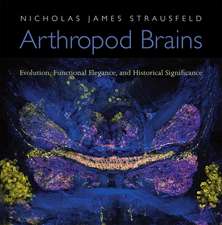Control of Poultry Mites (Dermanyssus)
Editat de Olivier Sparaganoen Limba Engleză Hardback – 22 iun 2009
| Toate formatele și edițiile | Preț | Express |
|---|---|---|
| Paperback (1) | 776.31 lei 38-44 zile | |
| SPRINGER NETHERLANDS – 21 oct 2010 | 776.31 lei 38-44 zile | |
| Hardback (1) | 947.35 lei 6-8 săpt. | |
| SPRINGER NETHERLANDS – 22 iun 2009 | 947.35 lei 6-8 săpt. |
Preț: 947.35 lei
Preț vechi: 1155.30 lei
-18% Nou
Puncte Express: 1421
Preț estimativ în valută:
181.33€ • 197.03$ • 152.42£
181.33€ • 197.03$ • 152.42£
Carte tipărită la comandă
Livrare economică 21 aprilie-05 mai
Preluare comenzi: 021 569.72.76
Specificații
ISBN-13: 9789048127306
ISBN-10: 9048127300
Pagini: 188
Ilustrații: VI, 146 p.
Dimensiuni: 155 x 235 x 17 mm
Greutate: 0.5 kg
Ediția:2009
Editura: SPRINGER NETHERLANDS
Colecția Springer
Locul publicării:Dordrecht, Netherlands
ISBN-10: 9048127300
Pagini: 188
Ilustrații: VI, 146 p.
Dimensiuni: 155 x 235 x 17 mm
Greutate: 0.5 kg
Ediția:2009
Editura: SPRINGER NETHERLANDS
Colecția Springer
Locul publicării:Dordrecht, Netherlands
Public țintă
ResearchCuprins
Control of poultry mites: where do we stand?.- Prevalence and key figures for the poultry red mite Dermanyssus gallinae infections in poultry farm systems.- Evaluation of the poultry red mite, Dermanyssus gallinae (Acari: Dermanyssidae) susceptibility to some acaricides in field populations from Italy.- Exploration of the susceptibility of AChE from the poultry red mite Dermanyssus gallinae (Acari: Mesostigmata) to organophosphates in field isolates from France.- In vitro efficacies of oils, silicas and plant preparations against the poultry red mite Dermanyssus gallinae.- Variation in chemical composition and acaricidal activity against Dermanyssus gallinae of four eucalyptus essential oils.- Inert dusts and their effects on the poultry red mite (Dermanyssus gallinae).- Candidate predators for biological control of the poultry red mite Dermanyssus gallinae.- The testing of antibodies raised against poultry red mite antigens in an in vitro feeding assay; preliminary screen for vaccine candidates.- The poultry red mite (Dermanyssus gallinae): a potential vector of pathogenic agents.- Endosymbiotic bacteria living inside the poultry red mite (Dermanyssus gallinae).- Molecular phylogenetic assessment of host range in five Dermanyssus species.- Phylogenetic relationship between Dermanyssus gallinae populations in European countries based on mitochondrial COI gene sequences.- Monitoring of Dermanyssus gallinae in free-range poultry farms.- Preventing introduction and spread of Dermanyssus gallinae in poultry facilities using the HACCP method.
Notă biografică
Dr Olivier Sparagano is a Senior Lecturer in Animal Production Science and the Director of Research in the School of Agriculture, Food and Rural Development at Newcastle University, UK. He is currently the President of the Society for Tropical Veterinary Medicine and the Honorary Meetings Secretary of the British Society for Parasitology. He has published more than 100 peer-reviewed scientific publications and over 200 conference abstracts on parasitology and related topics.
Textul de pe ultima copertă
This book summarises worldwide research activities at laboratory and farm levels to control the poultry red mites. 43 experts from 11 countries have been drawn into to present new control methods based on plants, predators or vaccine developments alongside updated chemical, physical and managerial approaches to tackle this ubiquitous ectoparasite which is responsible for economic costs for the poultry industry and for human health-related problems. Genetic and metabolomic diversity within the mite populations highlight the needs for an integrated approach for the poultry industry. Readers will understand the state-of-art in new research lines which could bring this worldwide and emerging ectoparasite under control.
Previously published in Experimental and Applied Acarology, Volume 48, Nos. 1-2, 2009
Previously published in Experimental and Applied Acarology, Volume 48, Nos. 1-2, 2009
Caracteristici
The first time that so many scientists working on Dermanyssus gallinae are confronting their results under field conditions or in laboratories to summarise what has been done in as many countries Research papers focus on biocontrol methods using plants, dust, predators, fungi or vaccines while other contributions will analyse the genetic diversity of poultry mite populations and its susceptibility/resistance to existing acaricides Some papers are focusing on a more preventative approach using the HACCP method to monitor and manage this pest on poultry farms













